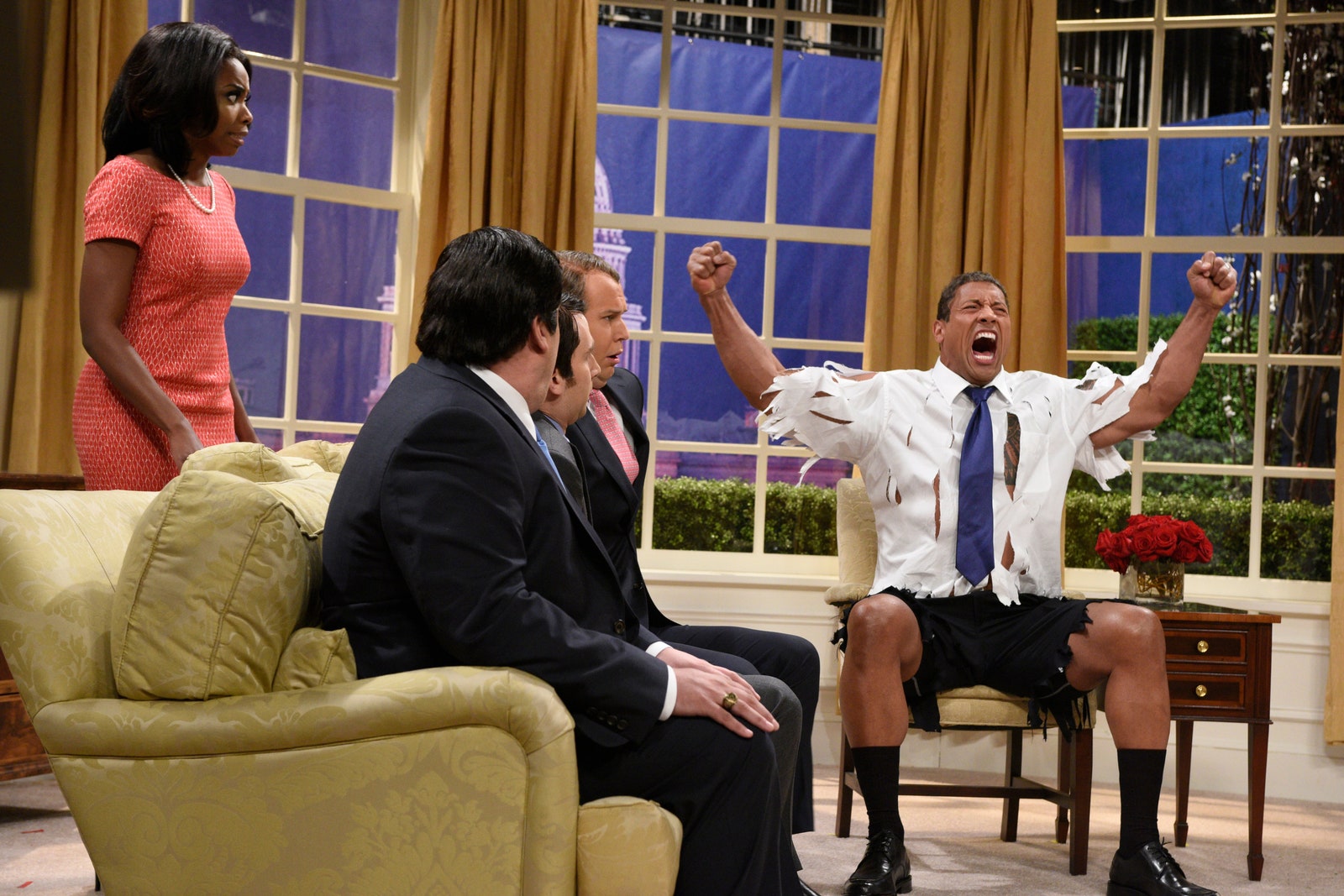In the S.N.L sketch “The Rock Obama,” Johnson plays another famous Black son of Hawaii.Photograph by Dana Edelson / NBC / Getty
There’s a running joke online that Johnson is always starring in the same film. “These are four separate movies,” one observer notes, sharing a grid of four stills that show Johnson clothed in either gray athleisure or a tan safari shirt open past the throat, standing against a variety of verdant tropical settings. The body always maintains its muscled shape and tone. The scalp is always buzzed to a gleaming smoothness. (“I’m not bald because I went bald,” Johnson has said. “I’m bald because my hair is a cross between an Afro and hair from a llama’s ball sac.”) The point is that the Rock is a star whose chief virtue is constancy. In his filmography, the hero’s love interests are chaste or die offscreen. Sex is some adolescent joke, and children are immaculately conceived. The arc of the HBO sports dramedy “Ballers” is, to me, emblematic of his Hollywood trajectory. In the first season, from 2015, viewers were treated to a shot of Johnson’s character, Spence, mid-screw, bare backside and all. Not long thereafter, the lucky woman was spirited away by the forces of plot, and over the following four seasons the show continued to find convenient reasons to disappear Spence’s girlfriends. By the end of the finale, he is the first Black majority owner in the N.F.L. Owing to a mysteriously declining sperm count, he may also be impotent.
The “Baywatch” remake, from 2017, was something of an outlier. As a bronzed and vulgar-mouthed lieutenant lifeguard, Johnson exuded virility. As a friend of mine put it, he “topped the fuck out of Zac Efron,” metaphorically speaking. But other roles from the decade—many of them made by Johnson’s production company, Seven Bucks–were both consistently prudish and racially all over the place. He played an all-American first responder with a white wife and daughter (“San Andreas”) and a Nigerian primatologist (“Rampage”). In the “Fast and Furious” franchise he was straight out of Samoa, joining a cast that had its fair share of all-American Negroes to balance out the frame.
Johnson was recruited into the “Fast” Fam by another light-skinned action hero, Vin Diesel, but the two men famously do not get along. The beef between them is telling. Diesel, who has called himself “Hollywood’s first multicultural megastar,” clearly feels that he’s owed some credit for Johnson’s success. “I’ve protected Dwayne more than he knows,” he has said. Unlike Johnson, Diesel has been deliberately coy about his racial identity offscreen. (“Is he Black or not? Vin Diesel won’t say,” a 2002 issue of Ebony teased—while nonetheless including him among its “57 Most Intriguing Blacks.”) In a nineties short film that he wrote and directed, called “Multi-Facial,” Diesel plays Mike, an actor on the audition circuit, struggling to fit in among Hollywood’s rigid racial codes. His ambiguous appearance allows him to audition for a wide variety of roles—Italian American, Latino, Black American—but prevents him from landing any of them. “I could read you but you’re really too light,” he’s told at one audition. In a prepared monologue, Mike tells a story about watching his father, also an actor, play Walter Lee in a production of “A Raisin in the Sun”: “My dad was a Black actor. But he wanted me to go one step further. He wanted me to be an actor. Just an actor.”
Vin Diesel and Johnson face off in a scene from “Fast Five.” The rivalry extends offscreen.Album / Alamy Stock Photo
You can see how Johnson would rankle. Diesel’s standout credits of the past decade have been restricted to the “Fast and Furious” series and a voice-acting role for Marvel, while Johnson has put his brown skin to work as the “Multi-Facial” protagonist only dreamed of (and, it should be noted, as a light-skin Black actress almost certainly couldn’t). Maybe it’s Diesel’s voice, which is indecently deep, with the texture of crushed velvet. Maybe it’s his face, which is too workmanlike to ever count as tentpole pretty. Meanwhile, the babyfaced Johnson was praised in Ebony for managing to “uphold and celebrate his Black and Samoan heritages equally,” and has proved himself apt at playing both and neither. Toward the end of “Fast Five,” Johnson and Diesel face off in a warehouse. We’re to understand them as equals, or foils, two men alike in complexion and grooming, on opposing missions who, as plot would have it, end up sharing a common goal. Diesel’s character wins the fight, but Johnson won the war.
Johnson’s performances have a way of throwing the Blackness of his fellow Black stars into relief. In Michael Bay’s heist movie “Pain & Gain” (2013), he got the relatively meaty part as an evangelical ex-con while his darker skinned costar, Anthony Mackie, was left to play the minstrel—“the big black man in tears,” as one character puts it. (The reason he cries: steroid-induced shrinkage.) His frequent team-ups with Kevin Hart, charming as they are, work in part because Hart is willing to embrace the kind of racialized gimmick that Johnson rejects. There is a scene in “Jumanji: Welcome to the Jungle” (2017) that is orchestrated for a bit of dick humor: three in-game avatars, played by Johnson, Jack Black, and Kevin Hart, stand pissing side by side. “I’m happy to report I was able to bring in one thing from the outside world,” Hart jokes, pleased with his virtual member. Black’s character tries to sneak a peek. Johnson’s, standing in the middle, is the only one who makes no mention of his own Johnson. He’s primarily concerned with aim.
I’m not opposed to Wesley Morris’s theory that Johnson’s sexlessness can be understood as a punitive byproduct of his Blackness. But what if it was all according to plan? Johnson has leveraged the elasticity of his racial identity to free himself from sexual baggage. He has sacrificed his natural intrigue and virtuosity at the altar of bankability.
There are signs, in his early films, of the stranger star who could have been. I am thinking, for instance, of “Be Cool” (2005), the sequel to “Get Shorty,” in which Johnson plays Elliot, a gay bodyguard for a thug-life wannabe played by Vince Vaughn. When I watch the movie I’m reminded that Johnson’s face and body used to really move. There was the People’s Eyebrow, yes, but also the People’s hips and torso. The character of Elliot is also an aspiring actor, and (through some plot michegoss) he ends up performing a scene from “Bring It On” that takes place between the characters played by Kirsten Dunst and Gabrielle Union. Delivering Union’s lines, Johnson’s entire posture changes: his hand goes on his hip, his fingers snap, his neck rolls, a diamond flashes in his ear. It’s silly but also rather risky—a Black Samoan man playing a “Samoan faggot” playing a mean Black hottie. On YouTube, one commenter declared, “This is the Rock’s greatest achievement in film.”
I’d be inclined to agree if it weren’t for his turn in “Southland Tales,” a knotty 2006 film by the writer-director of “Donnie Darko.” Johnson is Boxer Santaros, who has lost his memory as a consequence of experimental time travel. In his former life he was a movie star (and a Republican), but absent this knowledge he must now improvise his way into a new life. “You can see him trying on the various roles,” the critic Steven Shaviro has written. Twitchy and anxious and perpetually befuddled, Johnson here is very unlike any version of the Rock that fans had known. One of my favorite parts of his performance comes in an early scene with Seann William Scott, who (plot michegoss again) is playing a character trying on the role of a racist cop. “To be honest, we’re just looking for the niggers,” Scott’s character tells Santaros during a ride-along. The comment sets off a chain of facial reactions in Johnson’s character as he tries to determine whether the officer is joking, and comport himself accordingly. Stony one moment and tightly grinning when the camera cuts back a second later, Johnson’s face lends the scene its awkward comedic pulse. It is exhilarating to see the Rock trying to be somebody other than the Rock.
As Black Adam in the DC Extended Universe, Johnson has in theory turned heel again, as in his W.W.F. days. The character is an ancient baddie with an anger problem—technically a supervillain. Johnson has said that DC originally wanted the character slotted into the 2019 film “Shazam!,” a comedy, but that he insisted on going in a darker direction. Black Adam has been sold as a departure from the unimpeachable version of Johnson we know, and a harkening back to his own grittier origins. “Superman was the hero I could never be,” Johnson has said, recalling his rebellious youth. He’s boasted that Black Adam has no problem killing people, and the producers have advertised that the film barely secured its PG-13 rating. The spin seems to have paid off, commercially at least—“Black Adam” is Johnson’s best solo opening to date.
Johnson has said, of his role as the DC supervillain Black Adam, “Superman was the hero I could never be.”Photograph courtesy Warner Bros. Pictures
The color in the film’s title does not refer to race—not exactly. “The Black in Black Adam refers to his soul,” Johnson recently told Vanity Fair. The character, originally known as Teth-Adam, was born a slave in the fictional Middle East civilization of Kahndaq and was gifted with superpowers after rebelling against his enslavers. In the film’s present day, he has been summoned to save modern-day Kahndaq from colonial occupation (a thinly veiled allusion to Palestine). The role leaves little room even for the Rock’s signature charm. Adam speaks either in the fictional native tongue of Kahndaq or in halting English. A thickly built sentinel, he travels at warp speed and destroys indiscriminately. (The soundtrack to his first rampage: the Rolling Stones’ “Paint It, Black.”) Despite its subject matter, the film goes out of its way to disentangle itself from racial politics, assembling an equally diverse cast of do-gooders and antagonists. Yet there is an unwitting meta-comedy in the film’s insistence on only spiritual “darkness.” In a post-credits sequence, Viola Davis (as the DC honcho Amanda Waller) greets Adam in her lippy, trademark enunciation, underscoring—with a bit of annoyance, maybe—his new appellation: “O.K., Black Adam. Congratulations, you have my attention.”
There is a trace of delusion in Johnson’s idea that a superhero movie could herald his return to form. It is not a new observation that contemporary blockbuster franchises are uninterested in the body beyond its capacity as a weapon. “Sexuality doesn’t exist for superheroes–they are neutered,” Pedro Almódovar has said. In a recent interview, James Cameron observed of today’s action heroes, sounding perhaps a bit too high on his horse,“They all act like they’re in college. They have relationships, but they really don’t.” Black Adam was never going to be the role in which Johnson reclaimed his bestial side. There is one moment, though. It happens near the end, and, mindful of spoilers, I’ll just say that Adam is seated. We are looking up at him, as though kneeled at his feet, an unusual angle for films like these, which often care more about what’s going on above the torso than below. Johnson’s body language is a provocation: his legs are spread, casually, like a scumbag royal, his black skin suit stretching and flexing over his ample form. The image is suggestive, a signifier without a referent. What are Adam’s wants? What are his desires? (Does he have any besides revenge?) The film ultimately falls back on the trope of the “antihero,” which is to say that Black Adam’s soul is black but not too black. With the right branding, darkness can be something universal, too. “You may interpret him as a supervillain, antihero, protector, even a superhero,” Johnson said of the film, adding, “You may not agree with his philosophy, but everyone understands.” ♦







